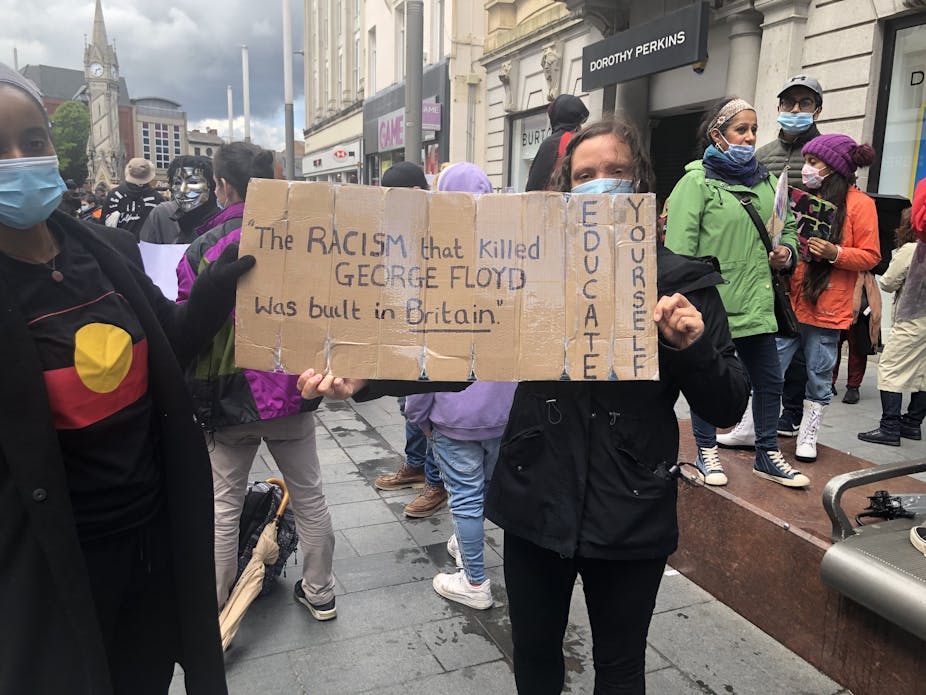In the face of the coronavirus pandemic that has disproportionately affected black, Asian and minority ethnic (BAME) communities, people across the globe have taken to the streets in protest. They have gathered in solidarity to express anger about George Floyd’s death and the persistence of police violence.
They are also calling out systemic racial injustices present in healthcare, education and public policy. This necessitates reasserting basic claims for the recognition of black humanity through the rallying cry “Black Lives Matter.”
But rather than looking across the Atlantic to understand why “Black Lives Matter” resonates so deeply in Britain, we need to first confront the repressed and disavowed histories of black life in the UK. These histories are all too often absent from the popular historical imagination of the nation. Yet, they frame the much-needed historical context for thinking through what we are bearing witness to in the present.
Untold histories
Community and political organising rooted in affirming the value of black life – work that is ever-present, but often overlooked – has gained increased visibility in recent weeks. As part of these organising efforts, there have been been renewed calls to reconstruct and reinterpret the built environment. We have seen this in the culmination of longstanding campaigns to remove the statues of slave owners Edward Colston and Robert Milligan.
Public debate has focused on whether or not such acts represent an attempt to erase aspects of British history. But at the heart of this discussion is an ongoing struggle to rethink accepted historical narratives and make visible the political work of the history.
History is being made in this moment. Previously revered narratives of Britain’s past are being questioned and omitted histories that need to be known are being told. These are the rich and complex stories of black life in Britain. Such histories are well-known within black communities, yet continue to be strategically silenced in our public understanding of British history.
There has been media coverage of the political solidarities that have long existed between anti-racist movements in the UK and US. However, we must consider why British students learn of Martin Luther King’s “I Have a Dream” speech, but not the march to the US embassy in London organised by Claudia Jones in solidarity with the 1963 March on Washington.
This march mobilised people in protest against the UK’s Commonwealth Immigration Act of 1962. Jones likened this policy to apartheid in the ways it created racialised barriers of entry for what was, at the time, a largely non-white migration of Commonwealth citizens to Britain.
The act established deportation procedures for British citizens born in the Commonwealth and empowered landlords to deny tenancies to those suspected of unlawful entry. Jones presciently understood how the 1962 act would lay the groundwork for today’s hostile anti-immigrant environment, which led to the Windrush Scandal.
We must ask why people learn of Rosa Parks through Dr Who but not the Bristol Bus Boycott or the bussing of black and Asian students in the 1960s and 1970s? This was done in places such as Bradford and Leicester to maintain majority white student populations. It highlights how race informed access to public education.
We must scrutinise why the collective British historical memory makes room for Stephen Lawrence while dispensing of Kelso Cochrane, David Oluwale, Aseta Simms, Joy Gardner and Christopher Adler. These names point to a history of state violence that informs how black communities in Britain are making sense of George Floyd’s murder.
We must interrogate how these histories – and those which define the history of race and racism in America – are routinely and deliberately severed from an understanding of the legacies of British imperialism.
Challenging myths of Britain’s past
We must ask these questions while also striving to understand why these circumstances persist. This demands embracing curriculum transformation coupled with teacher education. It also requires taking targeted action to redress the dismal numbers of black academics in history departments in UK universities. Moreover, it involves recognising the legitimacy of black British history as a field of inquiry.
In my book, London is the Place for Me, I explore the history of what I describe as the “mystique of British anti-racism”. I use this concept to chart the constellation of narrative myths about Britain. These are popular narratives that present Britain as tolerant, liberal, progressive, inclusive, humanitarian, benevolent and seemingly anti-racist.

The mystique of British anti-racism depends upon a wilful denial of the place of race and racism in British society. It is rooted in the politicisation of self-congratulatory historical narratives of British abolitionism.
Such narratives centre white reformers as enlightened saviours while whitewashing the violence of enslavement and the resistance of the enslaved. They traffic in the idea that anti-Black racism is something foreign. They insist that racism is the fault of a “small minority”, as the home secretary, Priti Patel, recently stated. They also maintains that racism operates on a spectrum of “better” or “worse” in comparison to other places. In all of these scenarios, the realities of those affected by racism are discounted or ignored.
Consequently, the mystique of British anti-racism is itself a dangerous and distorting set of narratives of British history that render black life as inessential and or inconsequential. This has the effect of becoming complicit in gaslighting or invalidating black people’s experiences of racism.
It is the “power in the telling” of histories of black life that allow us to challenge the mystique of British anti-racism. It allows us to bear witness to the insidious ways in which racism operates. It also provides much-needed perspectives of how black people have ingeniously and creatively devised strategies for living, surviving, resisting, anticipating and remaking conditions designed to devalue or disregard them.
This is why making black lives matter in British history is critical anti-racist work. It is an urgent agenda for the present that requires rethinking what we know about the past.

